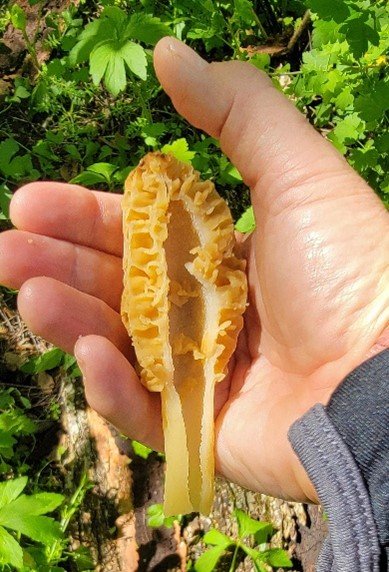Minnesota Master Naturalist Submission: Cheryl Batson
**Do not consume anything from the wild that a professional has not verified or accurately identified. Always be sure of the identification of the plant/fungi before consuming and avoid foraging in potentially contaminated areas. Misidentification can lead to serious illness or even death. Also, be sure to check local regulations and do not take more than you need.
Morels are considered a choice edible mushroom with a nutty, earthy flavor. It is a good start for beginners since they can be easy to identify. The Minnesota Mycological Society is a low-cost option for beginners in Minnesota to learn mushroom identification and the club holds forays (mushroom hunting) throughout the harvesting season. Also essential, is getting a good Minnesota mushroom identification book such as Mushrooms of the Upper Midwest by Teresa Marrone and Kathy Yerich. Being certain of your identification before eating any wild mushroom will help you prevent food poisoning and death. As with any wild food, only a small amount should be eaten to ensure you are not allergic, and check with your doctor before eating any wild foods when you are pregnant (especially mushrooms).
Morels grow from late April to June, with the later season in northern Minnesota. The season lasts about 2-4 weeks and begins when the lilacs start blooming in central and southern Minnesota, or when the first wildflowers start blooming in northern Minnesota. The highs need to be in the 70s and the ground warm and moist. Checking Morels.com or Greatmorel.com for morel sightings will help gauge the start of the season, especially in drought conditions. One of the best times to forage is on a sunny day about a week after a good rain. Be sure to recheck every week during the growing season as they grow rapidly.
Minnesota has two types of morels that grow in Minnesota, black and yellow. The black morels often appear first, before the lilacs bloom, and are found under hardwood trees and sumacs, or in disturbed areas such as campgrounds and trails. The yellow (or sometimes called white) morels come next. These are typically under dead or dying elm trees in much of central to southern Minnesota. Farther north they can be found under poplar or ash trees. Check out old apple orchards after knowing the area’s pesticide use, as well as burned areas. It is important to note that the tree preference varies in different states so it very well may change to ash trees as more ash trees begin dying in Minnesota due to emerald ash borer. The yellow morels typically follow the root lines so to follow it around the tree in a circle. Children, perhaps because they are lower to the ground, are especially good at finding morels so, be sure to bring them along! A long stick or hiking pole can also be useful to check for morels hiding in the leaf litter.
It is important to know the history of the land before harvesting morels. Morels can absorb lead and arsenic at toxic, carcinogenic levels. Use caution when harvesting in old apple orchards as arsenic and lead were used in apple pesticides throughout the 1900s to combat the codling moth. Arsenic is also used as a wood preservative in railroad tires, which leaches into the soil around it.
Only harvest in permitted locations. For Instance, Three Rivers Park District does not allow harvesting of any type. State Forests and State Parks allow mushroom harvest for personal use only. Please check regulations before harvesting on public land.
Morels are hollow from cap to stem when cut in half with irregular ridges on the cap.
False morels look similar to morels but are not completely hollow when cut in half. The cap hangs over the stem, the shape is more irregular, and the ridges are typically deeper. The Minnesota Mycological Society and other knowledgeable groups typically recommend against the consumption of false morels since it contains the toxin gyromitrin which is toxic to the liver.
Bring a knife or scissors with you to cut off the stem. Remove any dirt right away with a basting brush before placing it in your basket or mesh bag. Never store mushrooms in plastic or enclosed containers as they will spoil quickly. It is optional to wash the mushrooms before cooking.
There are many good recipes for morels. One of the easiest and most versatile is to make a morel butter log. Here is a link to one option: Savory Morel Butter Recipe on Food. Follow this recipe and then freeze the butter until you can shape it into a log like a sausage using wax paper. This takes about an hour, depending on the size of your log. Then you can simply cut off the amount you want to substitute for regular butter in a pasta or rice recipe, spread on bread, or melt on a burger or steak.


